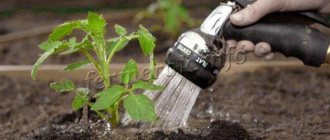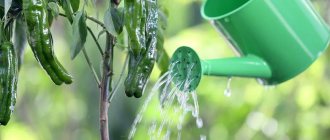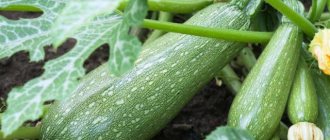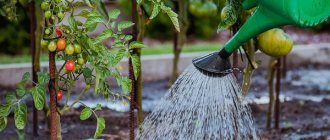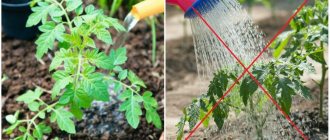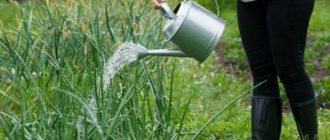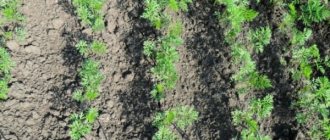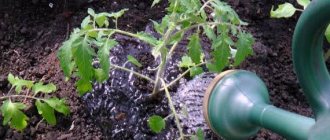Every gardener who wants to get a rich harvest should know how to properly and often water cabbage in open ground and the rules of watering Watering cabbage in open ground is very important for a full harvest. Among vegetable crops, cabbage occupies one of the main places. Caring for this plant is not difficult, so even beginners have it in their gardens. However, in order to get a good harvest, you must follow some rules for growing this vegetable. Particular attention should be paid to watering and feeding cabbage. Therefore, next we’ll talk about how to properly and often water cabbage in open ground .
How to properly water cabbage in open ground
- It is best to water cabbage in the early morning in normal weather, and on cloudy days watering can be done before lunch. In the southern regions, where there are often hot, dry days, the plant is watered late in the evening.
Important! In regions with cool climates, cabbage, like other vegetables, is not recommended to be watered in the evening.
- The plant is watered at the root. Water that gets on the cabbage head and leaves does not cause harm, unlike tomatoes. Some gardeners even carry out sprinkling procedures. In this case, the desired microclimate is formed on the site, which contributes to better development of cabbage.
- Since this crop is cold-resistant, it can be watered with cold water, but not during the period of planting seedlings. It is better, after all, to water the plant with warm water. You can always stock up on warm water by filling containers with water that will heat up in the sun.
- Water from a well can be icy, so it can harm the plant. If the water from the pipeline is not lower than +18-20, then it is quite suitable for watering cabbage. When watering the beds, it is necessary to ensure that the difference between the air and water temperatures does not exceed 10 degrees.
- If you use very cold water for irrigation in extreme heat, cracks may appear on the leaves and they will begin to rot. Water that is too warm can have a negative effect on the plant: the leaves and roots will become limp. Moreover, you should not use warm water in the middle of a hot day.
- This culture loves abundant and frequent watering. However, first of all you need to take into account the weather conditions. In dry and hot weather, cabbage should be watered once every 2-3 days. At the same time, you need to pour about 5 liters of water under each bush. On cloudy days in humid weather, you can water the beds every 4-7 days.
Important! You can tell whether cabbage needs watering or not by its appearance. The leaves will be limp and lie on the ground.
Watch the video! How often and how much to water cabbage
How to ensure proper soil moisture
How to understand that there is not enough moisture in the soil
It is very important to pay enough attention to soil moisture. In case of excessive dryness, head formation will not occur and cabbage growth will begin to slow down.
If dry weather sets in, the situation will worsen even more. When the air temperature is above +28 degrees, you need to water the cabbage every evening.
In order to understand that the soil is too dry, you need to pick up a piece of earth and make a ball out of it. If the ball cracks and crumbles in your hands, this is a sure sign that watering needs to be increased.
Signs of excess moisture
Do not forget that excessive watering can damage the plant. If the soil is over-moistened, the plant may die and you will lose your harvest. If the cabbage leaves have lost their elasticity and drooped, but after watering the elasticity is not restored, this means that the intensity of watering must be reduced.
What to do to prevent cabbage from cracking
Heads of cabbage may begin to burst if watering before and after the formation of forks is more intense than at the time of their appearance. The reason for this may be either an incorrect calculation of the amount of watering or untimely rains.
You should also pay attention to the fact that the heads of cabbage may also begin to crack due to overripeness of the cabbage. This means that the heads of cabbage will no longer increase in size and it’s time to collect them.
How to Preserve Cracked Heads of Cabbage
You can save heads of cabbage that crack during growth using two methods:
- cutting off part of the roots;
- turn the head of cabbage clockwise 90 - 180 degrees.
These methods will help reduce the nutrition of the heads of cabbage and ensure normal further growth without the appearance of even more cracks.
When and how often to water cabbage
To grow high-quality and tasty cabbage, you need to water it correctly. It is better to make a watering schedule in advance. At the same time, it is necessary to take into account not only the dryness of the soil. The roots of the plant have a branched shape and grow more than 15 cm deep into the ground. This entire area should be moist, but this is difficult to check.
By following all the rules of watering, the soil will always maintain the required moisture and looseness. The roots of the plant will be kept moist and will not rot. Also, there will be no waterlogging of the soil, which can lead to rotting of the roots and legs of the head of cabbage.
According to ripening time
After picking, water the cabbage immediately. During the growing season of any cabbage variety, until the head is created, it is well moistened daily. In wet weather, seedlings can be watered every other day. It is worth noting that watering seedlings largely depends on the climatic conditions of the region and weather.
- Dry time. If summer days are too hot and there has been no rain for a long time, then the crops should be watered once a day. In this case, you need to ensure that the soil is always moist, then the young seedlings will have enough moisture for their normal development.
- Frequent precipitation . During prolonged rains, which occur every day or every other day in large quantities, you can water the cabbage once every 3-4 days. If the soil is well moistened, then watering is not required.
- In warm regions , where the air temperature in summer is usually high, seedlings and adult cabbage are watered once every 2 days.
- But in the central regions of the country, this vegetable crop is watered only once every 7 days.
When growing early varieties of cabbage, which are particularly demanding of moisture, special attention should be paid to watering in June. During this initial growing season, the plant especially needs moisture. Late cabbage varieties need to be given more water in August when they reach maximum growth.
How often to water cabbage depending on the timing of its ripening:
- Early varieties of cabbage should be watered 2 days after the seedlings have been planted in a permanent place. Early cabbage varieties are watered for the last time 10–14 days before harvesting.
- Late types of this vegetable are watered when they are planted in the ground, and after 7 days watering is repeated. The last watering for late-ripening species is carried out 30 days before harvesting the heads of cabbage.
Important! During the most active formation of heads of cabbage, it is necessary to pour out about 12 liters of water per 1 square meter of field. During other phases of plant development, up to 7–8 liters of liquid can be used for the same area.
Depending on the type
- White cabbage . This type of cabbage requires the greatest amount of water in order for its leaves to be juicy and tasty. If all the rules of watering are not followed and an insufficient amount of liquid is added to the soil, the cabbage leaves become hard and dry. In addition, they develop many hard veins. At the initial phase of plant development, when its above-ground part is actively developing, 2 to 5 liters of water are added to each bush.
- Broccoli. In appearance, this variety resembles a dry vegetable. However, during its development it likes to consume a lot of water. Therefore, it is recommended to water broccoli once a week, 15 liters per 1 square meter of soil. At the same time, the soil should be moistened to a depth of 50 cm.
- Cauliflower . She will need less water. For 1 square meter of land you can use 10 liters of liquid. At the same time, watering is carried out once every 7 days. During the hot summer period, cauliflower, as well as broccoli, should be moistened up to 4 times a week.
- Early ripening Chinese cabbage. It requires no more than 12 liters of water per 1 square meter of land. Water, usually once every 7 days. This variety of cabbage ripens quickly, so it is recommended to water frequently and in small doses.
On different types of soil
- Dense soils . The disadvantage of such soil is stagnation of water. In this case, it is necessary to monitor the moisture of the soil and water it only when necessary.
- Light soil . Such soil can quickly absorb water and practically does not retain it. Then the time between watering processes is reduced.
- Nutritious loose soil. All varieties of cabbage can be planted on it. It absorbs water perfectly and allows air to pass through well.
- Acidic soil . Cabbage does not like this type of soil. It may not take root on such land at all or will produce poor-quality heads of cabbage. Before planting cabbage, dolomite flour or natural chalk must be added to areas with acidic soil.
- Swampy dense soils and peat bogs . Such areas should be equipped with a drainage layer to allow excess liquid to drain away. To do this, you can dig a ditch and put pebbles or sand in it. When planting seedlings, the top layer of the hole is filled with fertile soil, to which humus is added.
At different phases of the growing season
After planting seedlings in open ground, in warm weather they are watered no more than once every 2-3 days. 2 liters of liquid are immediately poured under each shoot. According to this scheme, watering is carried out for 14–20 days.
At the moment of active head formation, each cabbage requires up to 5 liters of water.
After the cabbage heads have formed , the periods between waterings are shortened, and the amount of water for each is reduced to 2-3 liters.
Important! Early cabbage varieties stop moistening 14–20 days before harvesting the vegetables. Late varieties of this crop are not watered a month before harvest.
Cauliflower loves a lot of water
The plant is very moisture-loving due to its weak root system and developing large leaves. The soil should always be moist before the heads begin to form.
Watering cauliflower is carried out every week in the evening at the rate of: per 1 sq. m. - 10 liters of water. If the weather is hot - 3 times a week.
Why don't the heads on cauliflower tie? Precisely because of lack of moisture. It is recommended to mulch the soil after watering.
Ways to water cabbage
To water this vegetable crop, gardeners use different methods. Most often they prefer sprinkling and drip irrigation. These methods of irrigating plants are the least labor-intensive process. In addition, cabbage receives sufficient moisture gradually, and this prevents it from stagnating.
Traditional
This manual method can be used to water any type of cabbage. It is produced using a watering can. Or the hose is laid along the rows along the entire length in the furrows.
Typically, this irrigation method is used for areas with fertile soil. Water, in this case, immediately gets under the bush to the roots, without affecting the cabbage leaves. For light soil, the classic method of watering is not recommended, as it does not retain moisture.
Drip
For gardeners who do not visit the site often, this watering method is the best option, but it will not cost them cheap. Thanks to a special design (ready-made or homemade), water flows to each bush gradually.
The system is made up of pipes and hoses that are branched in different directions. Thus, the area is constantly and evenly moistened, and the water goes directly to the roots of the cabbage. At the same time, the soil in the garden always remains loose.
This method is reminiscent of irrigation with natural precipitation. In this case, neither waterlogging nor drying out of the soil occurs. The drip irrigation method is also used to add nutrients along with water.
Sprinkling
During the formation of heads of cabbage, it is best to irrigate on the leaf. The sprinkling method cannot be used for seedlings. But, it is suitable for watering any type of soil. Watering the area is carried out using a special device that directs a stream of water upward under pressure. From a height, water falls onto the leaves of cabbage heads in the form of small drops.
The sprinkling method has some drawbacks: after watering, a dense crust forms on the ground. Therefore, when using this method of watering, the soil around the heads of cabbage must be loosened more often.
Combining watering with fertilizing
With any irrigation method, you can feed the plant together. The first application of fertilizer is carried out immediately when planting seedlings in a permanent place. The following substances are used to feed cabbage:
For the first feeding
- mullein or chicken droppings are diluted in water;
- nettle infusion;
- ammonium nitrate (1 tablespoon per 10 liters of water).
Strong fertilizers, which include manure and bird droppings, are diluted 1:20 with water; the solution should be administered only under the bush from a watering can. At the same time, you need to try so that the composition does not get on the head of cabbage.
For the second and third feeding, the following solutions are used:
- superphosphate (1 tablespoon per 10 liters of water);
- potassium salt (1 tablespoon per 10 liters of water).
When spraying a plant, it would be correct to use various infusions of herbs, for example, nettle, dandelion. For late varieties of cabbage, superphosphate can be used as a top dressing. When the cabbage leaves begin to turn yellow, irrigation can be combined with fertilizing with urea (1 tablespoon per 10 liters of water).
Caring for cabbage in autumn
In autumn, cabbage requires care, just like in summer. The following activities are carried out:
- Weed removal.
- Pollination with ash. This is both a fertilizer and a pest control product.
- Application of phosphorus-potassium fertilizers. They improve the taste and increase the shelf life of the vegetable.
- Fight against aphids using a soap solution.
When the heads of cabbage become elastic, they are cut off with a sharp knife, leaving a stalk of no more than 3 cm.
This is interesting:
How and what to water honeysuckle correctly: instructions for all seasons and periods
Instructions for watering carrots in August in open ground for beginner gardeners
How to water peppers in open ground correctly: instructions with advice from experienced gardeners
Watering and mulching
To prevent moisture from evaporating so much and to stay in the ground as long as possible, the rows of cabbage are mulched.
In this case, watering can be reduced. If necessary, the beds can be watered with mulch on top.
Hay and straw are used as mulch.
Another advantage of mulching is that weeds do not grow in this place, which saves the gardener from weeding.
When to stop watering
Before harvesting cabbage, watering is stopped. This time falls in the month of August.
Early varieties stop watering 10-15 days before harvesting heads, late varieties - 30 days. During this time, the soil will dry out, and the ripe heads of cabbage will not begin to rot from below. In this case, they will be easy to cut, and they will be well stored in winter.
If you do not adhere to this rule and continue to irrigate the vegetables, the cabbage stem will rot, which means the crop will be unsuitable for winter storage.
Watch the video! Watering cabbage in open ground
It is necessary to adhere to the rules of watering at all stages of development of this crop. Only in this case can you get a high and high-quality harvest.
Selection of water for irrigation
The temperature of the water used is essential. Too cold causes stress in the plant, provokes the development of fungal diseases and inhibits the root system, so well water and water collected from the well must be heated to +18...+23°C. In addition to heating, tap water also needs to be left in open containers - buckets, basins, etc., so that the chlorine can be removed from it. The best option would be collected rainwater, and natural reservoirs can only be used if they are not polluted by industrial and household wastewater.
